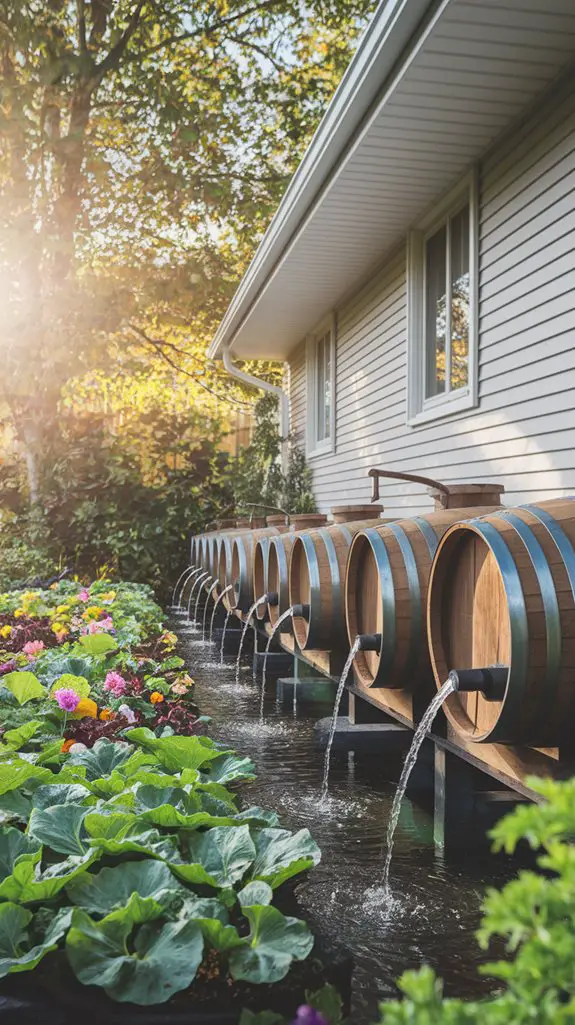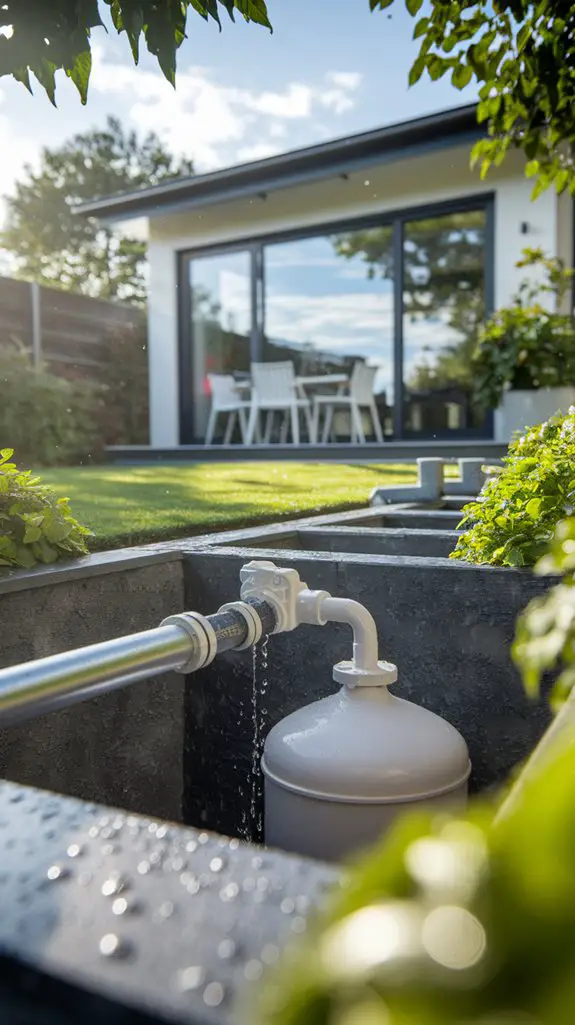Like Noah preparing for the flood, you can harness nature’s bounty right at home without breaking the bank. With water costs rising 41% in major US cities since 2010, rainwater harvesting offers a sustainable alternative that pays dividends over time. You’ll find that implementing these five affordable solutions requires minimal technical expertise while delivering maximum resource efficiency. The first option transforms your home’s infrastructure with just $100 and a weekend’s effort.
Simple Rain Barrel Systems for Budget-Conscious Homeowners
While commercial rainwater collection systems can cost thousands of dollars, DIY rain barrel setups offer an effective solution for under $100.
You’ll need a food-grade 55-gallon plastic drum ($15-40), a spigot kit ($5-10), mesh screening ($3-5), and basic tools.
Installing your system requires just four steps: drill a hole near the bottom for the spigot, create an overflow outlet near the top, cut an intake hole in the lid, and cover openings with mesh to prevent mosquito breeding.
Position the barrel on a raised platform (concrete blocks work well) to increase water pressure.
A single 55-gallon barrel can collect 0.6 gallons per square foot of roof area during a 1-inch rainfall—enough to water a 100 sq. ft. garden for a week. Additionally, using creative rainwater collection methods can enhance your garden’s water supply and efficiency.
DIY Gutter-to-Garden Collection Methods

When connecting your home’s gutters directly to garden areas, you’ll maximize both collection efficiency and irrigation functionality without requiring storage barrels. This direct routing system diverts rainwater to where it’s needed most while minimizing infrastructure costs.
- Slope calculation – Maintain a 1:100 minimum slope ratio (1cm drop per 100cm length) for ideal water flow without erosion risk.
- Channel selection – Use 4″ PVC pipes for volumes up to 500 gallons/hour or eco-friendly bamboo channels for lighter flows.
- Filtration integration – Install 1mm mesh screens at downspout entries to prevent debris clogging.
- Distribution options – Implement perforated pipes (5-10 holes per foot) for even moisture distribution or French drains (12″ deep, gravel-filled) for subsoil hydration.
These systems typically reduce irrigation needs by 40-60% annually while costing 75% less than commercial systems. Regular maintenance of the rainwater harvesting system is crucial to ensure optimal performance and longevity.
Low-Cost Underground Storage Tanks

Underground storage tanks offer three significant advantages over above-ground alternatives: temperature regulation (maintaining 50-60°F regardless of external conditions), space conservation (preserving valuable garden square footage), and enhanced water pressure (gaining 0.43 PSI per vertical foot).
You’ll find several budget-friendly underground options. Repurposed food-grade polyethylene drums ($75-150) provide 55-75 gallons of capacity when properly sealed and reinforced.
Pre-manufactured cistern systems ($500-1,200) offer 500-1,500 gallons with built-in filtration ports. For larger needs, consider concrete septic tanks ($1,200-2,500) which deliver 1,000-2,500 gallons and exceptional durability.
Installation costs vary: DIY trenching and positioning saves $800-1,200, while professional installation with excavation equipment runs $1,500-3,000.
Always check local codes regarding setbacks from foundations (typically 10+ feet).
Affordable Filtration and Pump Options for Home Use
Once your rainwater collection system is in place, effective filtration and pumping become essential for making this resource usable throughout your home.
You’ll need to balance cost with functionality when selecting these components.
For ideal home rainwater usage, consider these affordable options:
- First-flush diverters ($25-45) – Discard the initial runoff containing most contaminants
- Multi-stage filtration systems ($80-150) – Include sediment filters (5-20 micron) followed by carbon filters for chemical removal
- DC solar pumps ($120-200) – Operate at 24V with flow rates of 3-5 GPM, eliminating electrical costs
- Pressure tanks ($75-150) – Maintain consistent 40-60 PSI water pressure while reducing pump cycling by 30%
Additionally, integrating rainwater systems into ponds can enhance the overall sustainability of your water resources.
Combining these elements creates a reliable system that delivers clean rainwater at appropriate pressure without significant electricity consumption or maintenance costs.
Space-Saving Rainwater Collection for Small Yards
Limited outdoor space needn’t prevent you from implementing an effective rainwater harvesting system. Slim-profile tanks like the Slimline (30″ width) can hold 300-500 gallons while fitting against walls or fences. Vertical rain barrels offer 50-100 gallon capacity with a 24″ diameter footprint, ideal for corners. Wall-mounted collection systems integrate directly into downspouts, occupying zero ground space. Consider collapsible rain bladders (250+ gallons) that store under decks or porches when full and fold away during dry seasons. Multifunctional solutions include planter-barrel combinations and decorative rain chains paired with compact basins. For ultra-tight spaces, divert rainwater directly into subsurface irrigation systems or rain gardens using 4″ pipes, eliminating storage tanks entirely. Additionally, exploring compact rainwater systems can provide innovative options for maximizing efficiency in small backyards.
Conclusion
By implementing these five budget-friendly rainwater harvesting solutions, you’ll transform your property into a water-efficiency powerhouse, capturing up to 600 gallons from just 1″ of rainfall on a typical roof. You’re not just saving money—you’ll slash your water bills by an astounding 40-50% while creating a sustainable micro-ecosystem. Don’t wait for the next drought; these systems pay for themselves within 1-2 seasons while dramatically reducing your environmental footprint.




